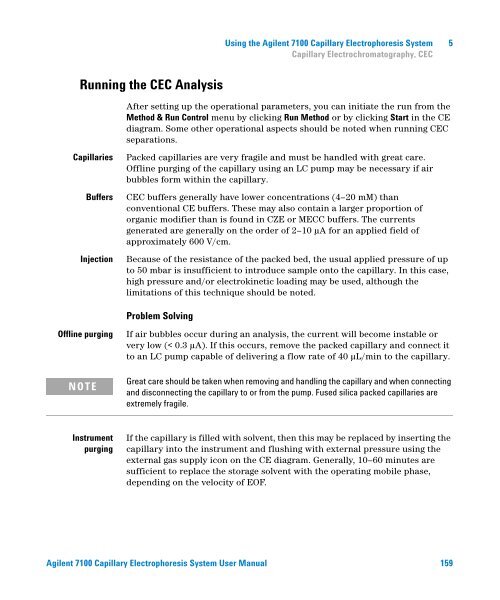Introduction to the Agilent 7100 Capillary Electrophoresis System
Introduction to the Agilent 7100 Capillary Electrophoresis System
Introduction to the Agilent 7100 Capillary Electrophoresis System
You also want an ePaper? Increase the reach of your titles
YUMPU automatically turns print PDFs into web optimized ePapers that Google loves.
Using <strong>the</strong> <strong>Agilent</strong> <strong>7100</strong> <strong>Capillary</strong> <strong>Electrophoresis</strong> <strong>System</strong> 5<br />
<strong>Capillary</strong> Electrochroma<strong>to</strong>graphy, CEC<br />
Running <strong>the</strong> CEC Analysis<br />
After setting up <strong>the</strong> operational parameters, you can initiate <strong>the</strong> run from <strong>the</strong><br />
Method & Run Control menu by clicking Run Method or by clicking Start in <strong>the</strong> CE<br />
diagram. Some o<strong>the</strong>r operational aspects should be noted when running CEC<br />
separations.<br />
Capillaries<br />
Buffers<br />
Injection<br />
Packed capillaries are very fragile and must be handled with great care.<br />
Offline purging of <strong>the</strong> capillary using an LC pump may be necessary if air<br />
bubbles form within <strong>the</strong> capillary.<br />
CEC buffers generally have lower concentrations (4–20 mM) than<br />
conventional CE buffers. These may also contain a larger proportion of<br />
organic modifier than is found in CZE or MECC buffers. The currents<br />
generated are generally on <strong>the</strong> order of 2–10 µA for an applied field of<br />
approximately 600 V/cm.<br />
Because of <strong>the</strong> resistance of <strong>the</strong> packed bed, <strong>the</strong> usual applied pressure of up<br />
<strong>to</strong> 50 mbar is insufficient <strong>to</strong> introduce sample on<strong>to</strong> <strong>the</strong> capillary. In this case,<br />
high pressure and/or electrokinetic loading may be used, although <strong>the</strong><br />
limitations of this technique should be noted.<br />
Problem Solving<br />
Offline purging<br />
NOTE<br />
If air bubbles occur during an analysis, <strong>the</strong> current will become instable or<br />
very low (< 0.3 µA). If this occurs, remove <strong>the</strong> packed capillary and connect it<br />
<strong>to</strong> an LC pump capable of delivering a flow rate of 40 µL/min <strong>to</strong> <strong>the</strong> capillary.<br />
Great care should be taken when removing and handling <strong>the</strong> capillary and when connecting<br />
and disconnecting <strong>the</strong> capillary <strong>to</strong> or from <strong>the</strong> pump. Fused silica packed capillaries are<br />
extremely fragile.<br />
Instrument<br />
purging<br />
If <strong>the</strong> capillary is filled with solvent, <strong>the</strong>n this may be replaced by inserting <strong>the</strong><br />
capillary in<strong>to</strong> <strong>the</strong> instrument and flushing with external pressure using <strong>the</strong><br />
external gas supply icon on <strong>the</strong> CE diagram. Generally, 10–60 minutes are<br />
sufficient <strong>to</strong> replace <strong>the</strong> s<strong>to</strong>rage solvent with <strong>the</strong> operating mobile phase,<br />
depending on <strong>the</strong> velocity of EOF.<br />
<strong>Agilent</strong> <strong>7100</strong> <strong>Capillary</strong> <strong>Electrophoresis</strong> <strong>System</strong> User Manual 159
















